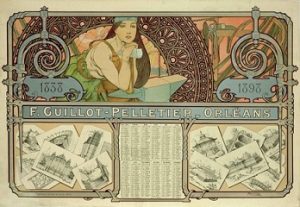
© Penguin Classics
Anyone born at a similar time to me, and in a similar part of the world, and who therefore grew up watching 1970s British television, will have difficulty reading a novel about a department store without being reminded of the saucy British TV sitcom Are You Being Served?, created and written by David Croft and Jeremy Lloyd, broadcast from 1972 to 1985 and, yes, set in a department store in contemporary London.
Even though the novel in question is the classic French one The Ladies’ Delight (Au Bonheur des Dames) written by Émile Zola, published in 1883 and set in Paris, I’m afraid that while I read it I kept hearing in my head Ronnie Hazelhurst’s theme song from Are You Being Served? This was a simple but maddeningly relentless number wherein a lift-girl talks over the non-stop chiming and chattering of a cash register: “Ground floor, perfumery / Stationery and leather goods / Wigs and haberdashery / Kitchenware and food / Going uu-uup…!” I’ve heard people claim that the Are You Being Served? theme invented rap music, but maybe that’s pushing it a bit.
Anyway, on a more serious note… I admire Émile Zola because of his variety. He didn’t confine himself to writing about one particular section of society but gave each of his novels a different and distinctive focus. For example, Nana (1880) is set in Paris’s theatrical world while Germinal (1885) is set in a mining community in northern France. The Beast in Man (1890) deals with workers on the French railways while The Debacle deals with soldiers fighting and civilians caught up in the Franco-Prussian War. Thus, his body of work becomes a massive, fictionalised document of French life in the mid-to-late 19th century.
With The Ladies’ Delight, Zola turns his attention to retailing industry and the changes it was undergoing at that time. He tells the story largely through the eyes of young woman, Denise Baudu, who arrives in Paris from the provinces in the 1860s and finds work as a saleswoman at a booming department store, the titular Au Bonheur des Dames.
Denise’s job at the store is troubled from the start. By working there, she incurs the displeasure of her only Parisian relatives, her uncle Baudu and his family, whose little draper’s shop has the misfortune of being across the street from Au Bonheur des Dames and is quickly being put out of business by it. She comes to the capital with her two younger brothers, teenaged Jean and little Pépé, and Jean – with an irresponsibility typical of many of Zola’s male characters – is soon sponging off her while she barely earns enough to keep Pépé fed, clothed and in school and keep herself alive. In fact, she almost doesn’t get employed at Au Bonheur des Dames at all. On the day she applies for a job, the general overseer Bourdoncle rejects her for being ‘too ugly’. But he’s overruled by the store’s owner, Octave Mouret, who hires the rustic-looking and waif-like Denise on a whim.
Nor does Denise – gentle, principled and clean-living – prosper in the licentious and back-biting environment of Au Bonheur des Dames. The intensity of her workmates’ carnal obsessions is matched only by their determination to shin their way up the promotional ladder, usually by plotting against and undermining whoever’s immediately above them. She’s eventually dismissed and finds a new job with Robineau, a one-time buyer at the store who was himself elbowed out and has now taken over a shop selling silk garments. But Robineau’s business is unable to compete against the remorselessly growing, evermore popular establishment he once worked for, and he’s soon forced to let Denise go. However, she manages to get back onto Au Bonheur des Dames’ payroll and this time she gains the ear of her boss, Mouret. Though she’s naïve, Denise has excellent common sense and an unerring instinct for knowing what the public wants. The advice she gives Mouret about how best to treat his customers, and his employees, leads to her rapid promotion. Meanwhile, the cynical, worldly-wise Mouret starts to find himself unaccountably attracted to her…

From wikipedia.org
As well as relating the ups and downs of Denise’s career in and outside Au Bonheur des Dames, Zola describes Mouret’s efforts to expand his business and reel in more customers. His activities include becoming the beau of society widow Madame Desforges, in order to get access to the super-powerful Baron Hartmann, who’s another of Madame Desforges’ lovers. (Well, these folks are French.) If he can secure Hartmann’s financial and political backing, Mouret believes he can grow Au Bonheur des Dames until it encompasses an entire city block. Mouret’s romancing of Madame Desforges, and the flirting and flattering he does with the wealthy ladies who make up her social circle, become a metaphor for the seduction of Paris’s female shoppers that his store is performing on a commercial level.
However, it’s the novel’s third strand that’s the most powerful. This describes the impact that Au Bonheur des Dames has upon the traditional shopkeepers who specialise in one particular type of good and are unlucky enough to share a neighbourhood with it. The store begins by ruining the drapers but, as it gets bigger and Mouret creates more departments and sells a wider range of products, it also threatens the local furriers, glovers, hatters and so on. Mouret even encroaches on the business of an old man called Bourras who looks ‘like an Old Testament prophet’ and makes and sells umbrellas and walking sticks. Bourras’s decrepit shop occupies a sliver of one of the street-fronts that Mouret is expanding his premises along. The old man refuses to sell and move out, so that his shop ends up with Au Bonheur des Dames on either side of it and resembles a ‘wart’ in its grand façade.
Denise’s Uncle Baudu not only loses his draper’s business but also his daughter Geneviève to the store. Geneviève’s fiancé abandons her after becoming infatuated with a coquettish salesgirl working across the street, and the broken-hearted Geneviève wastes away and dies. Her funeral provides the novel with its most effective scene. The mourners include all the shopkeepers who’ve had their trade pulverised by Au Bonheur des Dames and they’re obliged to follow the coffin past the building that’s the source of their misery. Old Bourras laments, “Oh, we’re a pretty sight; a fine cortege of carcasses we make for the dear child! It must be odd, for people watching this line of bankrupts going past. And it seems that the clean-out is continuing. The scoundrels are opening departments for flowers, for fashions, for perfumes, for shoes, and who knows what else?”
While Zola doesn’t hold back in depicting Au Bonheur des Dames as a rapacious monster, his imagination is clearly besotted with the place as well. He devotes many pages to describing it. It’s variously likened to ‘an awakening beehive’, ‘an enormous fairground display’, ‘a sumptuous pasha’s tent’, ‘a cathedral of modern trade, light yet solid, designed for a congregation of lady customers’, ‘a monumental gallery’, ‘an enormous carnival’, ‘a vast, many-coloured architectural pile with gold highlights’, ‘a boreal vista’, ‘a great love nest’, ‘a white chapel’ and ‘a dream heaven, a window into the dazzling whiteness of a paradise.’ Whenever you think Zola has finished writing about its appearance, he has Mouret give the premises another upgrade and off he goes on another flurry of description.
In my mind’s eye, I found myself embellishing the store’s architecture and décor with flourishes of Art Nouveau. I visualised the building as resembling some grand project designed by an Art Nouveau artist like Alphonso Mucha, Koloman Moser or Eugène Grasset. But that would be wrong, since the novel’s 1860s setting precedes the Art Nouveau movement by at least 20 years and those artists would have been youngsters at the time.

From alphonsemucha.org
The Ladies’ Delight isn’t one of Zola’s best books. His lengthy descriptions become tiresome. This is especially true towards the end, when the reader is impatient to see how the various plot strands will be resolved and when those descriptions just seem to get in the way. Also an issue is the characterisation. Denise seems too innocent to be true, especially when there’s such a rogue’s gallery of schemers, chancers and letches inhabiting the store around her. Correspondingly, it seems unlikely that somebody like Mouret could fall for her, even briefly – let alone become obsessed with her, to the point where he loses interest in everything else, including his business, as he does later. (Predictably, the virtuous Denise rebuffs all his advances, which only leaves him more smitten with her.)
Enterprises launched by characters in Zola’s books tend to overreach themselves and come crashing down, both small-scale ones like Gervaise’s laundry business in L’Assommoir (1877) and grand ones like the title character’s theatrical career in Nana. But that doesn’t happen to Mouret’s store in The Ladies’ Delight. It simply continues to grow – the cash-register from Ronnie Hazelhurst’s Are You Being Served? theme was clinking particularly loudly in my head during those scenes where Zola describes the cashiers struggling to count and gather up and lock away Mouret’s ever-swelling profits. In the absence of Mouret getting his financial come-uppance, I suppose Zola felt obliged to give him a romantic come-uppance instead, which is where he deploys Denise. But as a plot device it doesn’t feel plausible.
The Ladies’ Delight is effective, though, when it chronicles how the new store tramples all over the businesses of the old-style traders and leaves a trail of bankruptcies in its wake. It’s ironic to reflect that in 2020 the same department store would probably be a much-loved historical landmark. It’d be regarded as an important, if vulnerable, part of its city’s commercial heritage. Fearful that modern online traders like Amazon might trample all over its business, citizens would be calling on the government to subsidise it and keep it propped up.
Yes, this youthful monster of 19th century capitalism would now be regarded as, potentially, an elderly victim of 21st century capitalism. The French saying ‘plus ça change, plus c’est la même chose‘ isn’t quite true.
